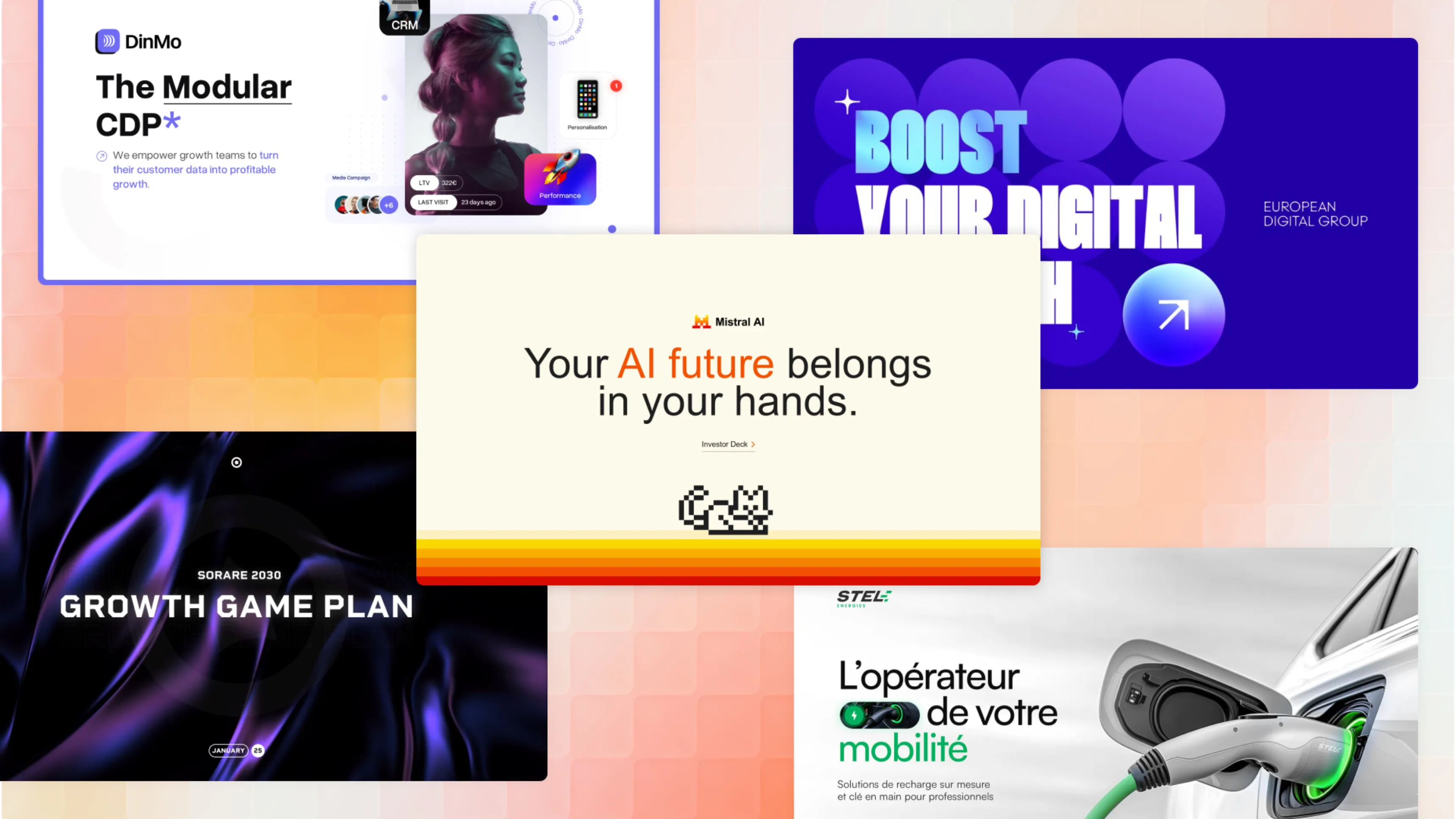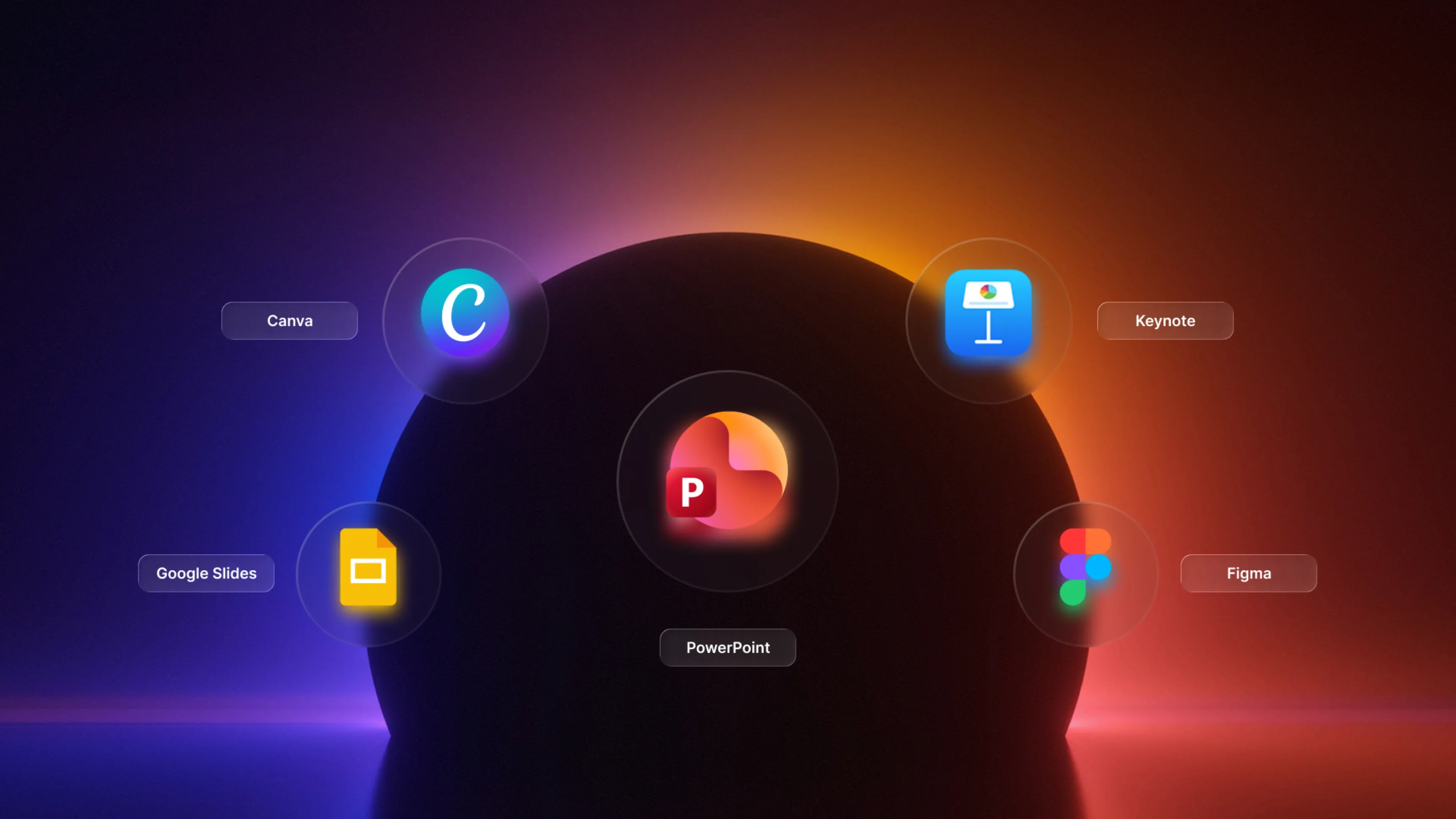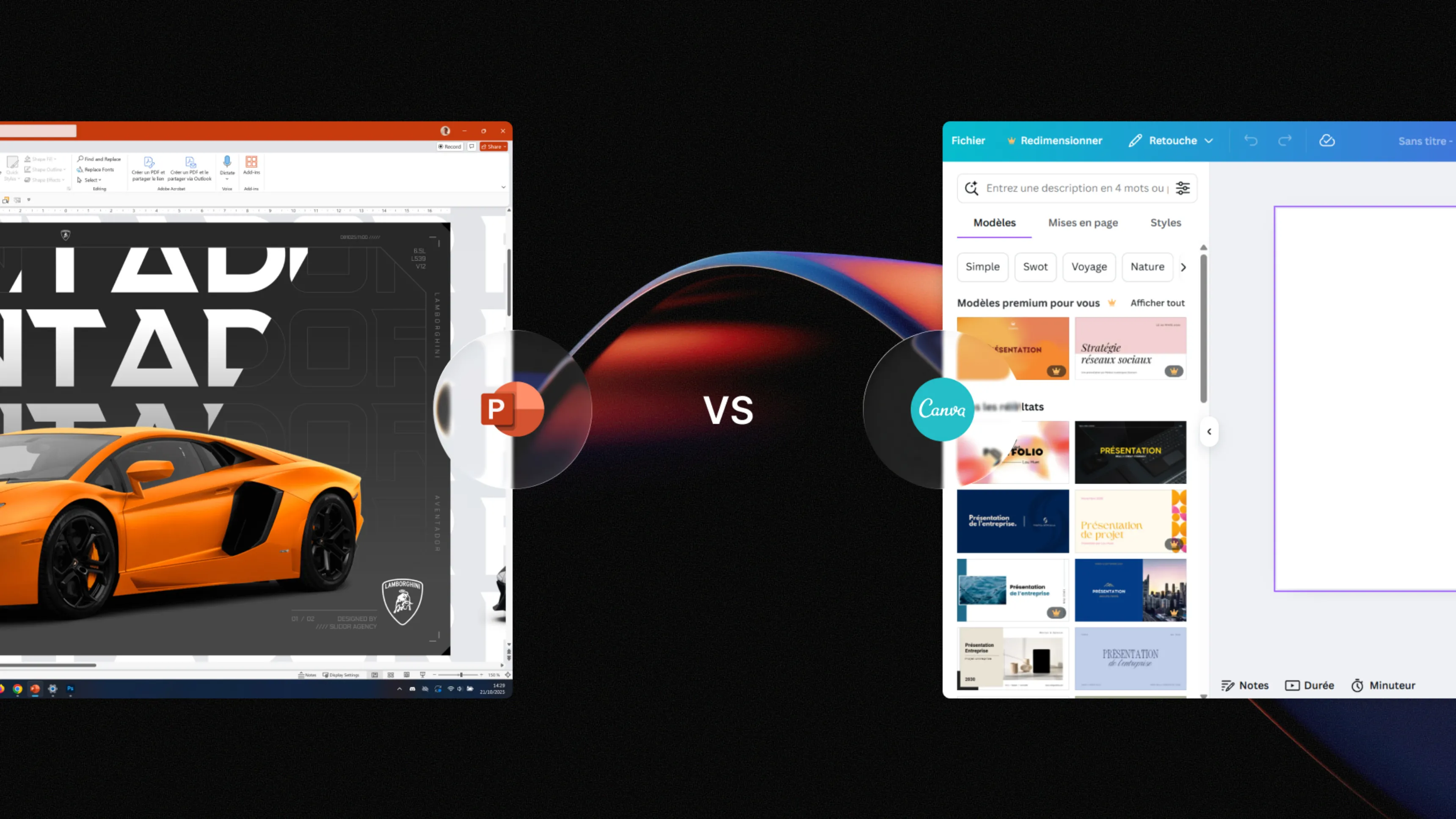.svg)
How to present an effective pitch (templates included)
Pitch examples serve as models for building effective arguments in different contexts. They illustrate the practical application of the principles of persuasion, the narrative structure and the adaptation to the target audience. Pitches vary according to the objective: raise funds, sell a product, present a project or present yourself professionally. Each example shows how to capture attention, communicate value, and inspire action.
Author
Jérôme Bestel
Updated on
November 14, 2025
Created on
Category
Analysis


Join the thousands of businesses and executives who have trusted Slidor to turn their slides into high-impact presentations.



Types of Pitch and Contexts
Company Pitch and Fundraising
The fundraising pitch addresses investors to obtain financing. It must demonstrate business model viability, growth potential, and return on investment. A mastered oral presentation reinforces the impact of your financial argument. To maximize your chances of success, discover how to effectively structure a pitch deck that attracts investors.
💡 Key point: Investors evaluate the opportunity as much as the team carrying it. Highlight your skills and legitimacy.
| Pitch element | Allocated time | Main objective |
|---|---|---|
| Identified problem | 2-3 minutes | Demonstrate market pain |
| Proposed solution | 3-4 minutes | Explain innovation |
| Business model | 2-3 minutes | Prove profitability |
| Team and traction | 3-4 minutes | Reassure on execution |
Sales Pitch
The sales pitch aims to convince a prospect to buy a product or service. This approach requires personalization according to the interlocutor's particular stakes. An effective sales presentation relies on a structure adapted to each customer.
Essential sales pitch components:
1. Need qualification - Ask questions to understand the situation
2. Targeted presentation - Adapt speech to identified stakes
3. Value demonstration - Show measurable results
4. Objection handling - Anticipate and respond to barriers
5. Closing - Propose clear next step
⚠️ Caution: Only talk about your solution after clearly identifying and validating customer need.
Elevator Pitch and Networking
The elevator pitch is an ultra-concise 30 to 60-second presentation used during networking events. The objective is to arouse interest for a subsequent conversation.
An effective elevator pitch answers three questions: who are you, what do you do, and why should it interest your interlocutor.
Startup Pitch Example: Slidor
Here is a concrete pitch example for a technology startup seeking seed funding.
Problem Presentation
"Every year, French companies lose 12 billion euros due to ineffective PowerPoint presentations."
The problem breaks down into three dimensions: time spent creating mediocre presentations, commercial opportunities lost due to lack of visual impact, and design agency costs too high. Sales teams spend an average of 8 hours per week creating presentation materials.
⚠️ Caution: When presenting a problem, ensure it resonates with your investors' personal experience.
Solution Description
"Slidor transforms any PowerPoint presentation into professional material in less than 48 hours thanks to a team of expert designers."
Our presentation design agency connects companies with presentation design specialists. Clients submit their content, our designers optimize it according to best practices, and the final result is delivered with unlimited revision service.
Our differentiation rests on three pillars:
1. Speed - Delivery in 48h maximum vs 2-3 weeks for traditional agencies
2. Price - €300-800 per presentation vs €3000-5000 in classic agency
3. Quality - Designers specifically trained in professional presentations
The business model combines monthly subscription for regular clients and on-demand billing for one-time needs. Our gross margin reaches 65%.
Traction and Market Validation
"In 6 months, we generated €145,000 in revenue with 89 active clients, including 34% in renewal."
Our average monthly growth rate stands at 28%, primarily fueled by word-of-mouth. Customer acquisition cost (CAC) is €180 for a customer lifetime value (LTV) of €2400.
| Key metric | Current value | 12-month objective |
|---|---|---|
| Monthly revenue | €24,000 | €120,000 |
| Number of active clients | 89 | 450 |
| Retention rate | 68% | 75% |
| Gross margin | 65% | 70% |
📋 Quick summary: Traction demonstrates that product-market fit is achieved. Investors seek concrete proof of market adoption.
Call to action: We are raising €500,000 to accelerate our commercial growth and develop our technology platform. These funds will finance recruitment of 3 salespeople, project management automation, and a targeted marketing campaign.
Sales Pitch Example
A sales pitch adapts to the prospect's specific needs. Here is an example for project management software.
Customer Need Identification
"You mentioned that your teams spend too much time in coordination meetings and that information gets lost between tools."
This reformulation demonstrates active listening and validates customer problem understanding.
Typical qualification questions:
- How many projects do you manage simultaneously?
- What tools do you currently use?
- What is the cost of these inefficiencies for your organization?
- What have you already tried to solve this problem?
Value Demonstration
"Our solution centralizes all project communication in a single space accessible to the entire team."
The demonstration must be interactive and contextual. Use examples close to the prospect's business sector. Show rather than explain: a live demonstration is worth more than a feature presentation.
💡 Key point: Each presented feature must be linked to a concrete benefit. The formula "which means that..." transforms features into advantages.
"Companies like [similar client name] reduced their coordination time by 40% in three months."
| Customer benefit | Success metric | Achievement timeframe |
|---|---|---|
| Meeting time reduction | -35% to -45% | 6-8 weeks |
| Project visibility improvement | +60% team satisfaction | 4 weeks |
| Deliverable delay decrease | -50% delayed projects | 3 months |
Objection Handling
Objections are clarification opportunities, not refusals.
Price objection: "It's above our current budget."
Response: "I understand. Let's look together at the cost of current inefficiency. If you save 10 hours per week per manager, what is the return on investment?"
Timing objection: "It's not the right time."
Response: "What would be the ideal time for you? What elements need to be in place for it to be the right timing?"
Competition objection: "We're also looking at other solutions."
Response: "Excellent approach. What criteria are you using to compare? I can help you structure your evaluation." A solid sales argument transforms objections into dialogue opportunities.
⚠️ Caution: Never directly disparage competition. Highlight your positive differences.
Closing proposition: "I propose we start with a 30-day pilot project with three of your teams. This will allow you to measure impact before full deployment."
Elevator Pitch Example
The elevator pitch condenses the essential in 30 to 60 seconds maximum. Every word counts.
Concise 30-Second Presentation
Example for a startup founder:
"I'm Jerome, founder of Slidor. We help companies create professional PowerPoint presentations 10 times faster than traditional agencies, for one-tenth the price. In 6 months, we've won 89 clients including several CAC 40 companies. We are currently raising funds to accelerate our growth."
Elevator pitch anatomy:
1. Identification (1 sentence) - Who you are, what is your role
2. Value proposition (1-2 sentences) - What you do and for whom
3. Differentiation (1 sentence) - Why it's unique or remarkable
4. Proof (1 sentence) - Traction, result, validation
5. Opening (1 sentence) - Question or follow-up proposal
Memorability and Impact
A memorable elevator pitch uses striking comparisons and rounded figures easy to remember. "10 times faster" is more impactful than "87% reduced delay".
💡 Key point: Test your elevator pitch with people unfamiliar with your domain. If they can't repeat the essential after hearing it once, simplify.
Using the rule of three: The human brain easily retains information grouped by three. "Faster, cheaper, better quality" is more memorable than a list of six advantages.
Adaptation to Interlocutor
The elevator pitch is not a fixed recitation. Adapt it according to your audience.
| Interlocutor type | Main focus | Call to action |
|---|---|---|
| Investor | Growth and profitability | "We are raising funds" |
| Potential customer | Problem resolution | "May I send you a case study?" |
| Partner | Synergies and opportunities | "Let's explore a collaboration" |
| Recruiter/talent | Mission and impact | "We're recruiting profiles like yours" |
Observe your interlocutor's non-verbal reactions during the pitch. If you detect interest on a specific point, develop it immediately.
Structure of an Effective Pitch
Hook and Problem Statement
The hook constitutes the pitch's first 15 seconds. It must immediately captivate attention and create emotional connection.
Effective hook techniques include a provocative question, a surprising statistic, or a relevant personal anecdote.
📋 Quick summary: A good hook answers the audience's silent question: "Why should I listen?"
| Hook type | Application example | Effectiveness by context |
|---|---|---|
| Rhetorical question | "How many prospects do you lose due to lack of follow-up?" | Very effective in B2B |
| Shocking statistic | "73% of startups fail due to lack of product-market fit" | Ideal for investors |
| Personal story | "I lost €50,000 because of this mistake..." | Powerful for networking |
Solution and Differentiation
After establishing the problem, present your solution as a logical and necessary response. Explain your approach in simple terms, without excessive technical jargon.
Differentiation elements to highlight:
- Technological or methodological innovation
- Sustainable competitive advantage
- Barriers to entry for competitors
- Intellectual property or unique expertise
💡 Key point: Don't say you're "better" than competition. Demonstrate how you're different and why this difference matters.
Proof of concept validates your promise with factual elements. Use customer testimonials, case studies, or pilot results. Quantified data reinforces credibility: improvement percentage, time saved, revenue generated.
Call to Action
The call to action concludes the pitch by proposing a clear next step. Never leave the audience wondering "and now, what happens?"
Depending on context, your call to action can be a meeting request, an invitation to test the product, or an investment proposal. A good call to action facilitates decision by reducing friction: propose a date, send a link, offer a free trial.
Key Persuasion Elements
Storytelling and Data
Storytelling transforms an informative pitch into memorable experience. An effective narrative structure follows the classic dramatic arc: initial situation, disruptive problem, final solution. Discover storytelling techniques to captivate your audience from the first seconds.
💡 Key point: Investors invest in stories, not spreadsheets. Data validates the story, but it's the vision that inspires commitment.
Proof credibility hierarchy:
1. Measurable customer results - ROI, savings, growth
2. Commercial traction - Revenue, number of clients, retention
3. External validation - Awards, press mentions, partnerships
4. Market studies - Market size, trends, projections
| Proof type | Persuasive impact | Ease of obtaining |
|---|---|---|
| Customer video testimonial | Very high | Medium |
| Detailed case study | High | Medium |
| Usage statistics | Medium | Easy |
| Third-party studies | High | Difficult |
Clarity and Conciseness
Clarity eliminates all ambiguity about what you do, for whom, and why it matters. Test with the "grandmother test": could your grandmother explain your activity after hearing your pitch once?
Clarity obstacles to avoid:
- Unexplained technical jargon
- Complex sentences with multiple subordinate clauses
- Abstract concepts without concrete examples
- Too much simultaneous information
⚠️ Caution: A too-dense pitch tires the audience even if it's short. Integrate natural pauses and synthesis moments.
Single sentence technique: Can you summarize your value proposition in one clear sentence? This sentence becomes your thread throughout the pitch.
Frequently Asked Questions
What is the ideal duration of a pitch?
Duration depends on context: 30 seconds for elevator pitch, 3-5 minutes for initial sales pitch, and 10-20 minutes for investor presentation. Always adapt to available time and prepare a short backup version. The essential is to capture interest enough to obtain a subsequent in-depth conversation.
How to structure a pitch without prior experience?
Follow the problem-solution-proof-action structure that works universally. Start by clearly identifying the problem you solve, present your solution simply, provide validation elements even modest (beta-testers, first clients), and finish with clear call to action. Focus on clarity rather than exhaustiveness.
What are the most common errors in a pitch?
Main errors include: starting by talking about yourself rather than customer problem, using too much technical jargon, presenting too many features unrelated to needs, lacking concrete proof, and not concluding with clear call to action. An effective pitch focuses on value for audience, not product features.
How to adapt a pitch according to audience?
First identify your audience's main motivations: investors seek financial return, clients seek problem resolution, partners seek synergies. Adapt your language, examples, and metrics accordingly. The same product can be presented as investment opportunity, operational solution, or technological innovation depending on interlocutor.
Should you memorize your pitch word for word?
No, memorizing word for word makes the pitch rigid and artificial. Rather master the structure, key points, and main transitions. You must be able to adapt content according to audience reactions and emerging questions. Practice enough to be fluid without being robotic, while keeping improvisation capacity.



















